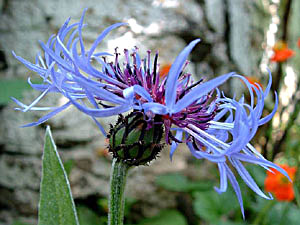
medicinal herbs
Mountain Cornflower
Centaurea montana

Herb: Mountain Cornflower
Latin name: Centaurea montana
Family: Compositae
Medicinal use of Mountain Cornflower:
Mountain cornflower is seldom used in modern herbalism, though it does still have a reputation in parts of Europe as a wash for tired eyes. It is considered to be most effective on blue eyes, great plantain (Plantago majus) being used for brown eyes. The dried flowers are antitussive, astringent, weakly diuretic, emmenagogue, ophthalmic, very mildly purgative and tonic. An infusion can be used as a treatment for dropsy, constipation, as a mouthwash for bleeding gums and as an eye bath for conjunctivitis.Description of the plant:

Plant:
Perennial
Height:
45 cm(1 foot)

Flowering:
May toAugust
Habitat of the herb:
Mountain woodland margins and meadows.Other uses of Mountain Cornflower:
Can be used as a ground cover plant in a sunny position.Propagation of the herb:
Seed - sow March in a greenhouse. When they are large enough to handle, prick the seedlings out into individual pots and plant them out into their permanent positions in the summer. The seed is best sown as soon as it is ripe in August in a greenhouse, overwintered under cover, and planted out in spring. Division in autumn. Very easy, larger clumps can be replanted direct into their permanent positions, though it is best to pot up smaller clumps and grow them on in a cold frame until they are rooting well. Plant them out in the summer or following spring. This should be done at least once every three years in order to maintain the plants vigour. Basal cuttings in spring. Harvest the shoots when they are about 5 - 10cm long with plenty of underground stem. Pot them up into individual pots and keep them in light shade in a cold frame or greenhouse until they are rooting well. Plant them out in the summer.Cultivation of Mountain Cornflower:
Mountain woodland margins and meadows.Known hazards of Centaurea montana:
None knownPlant information taken from the Plants For A Future.
